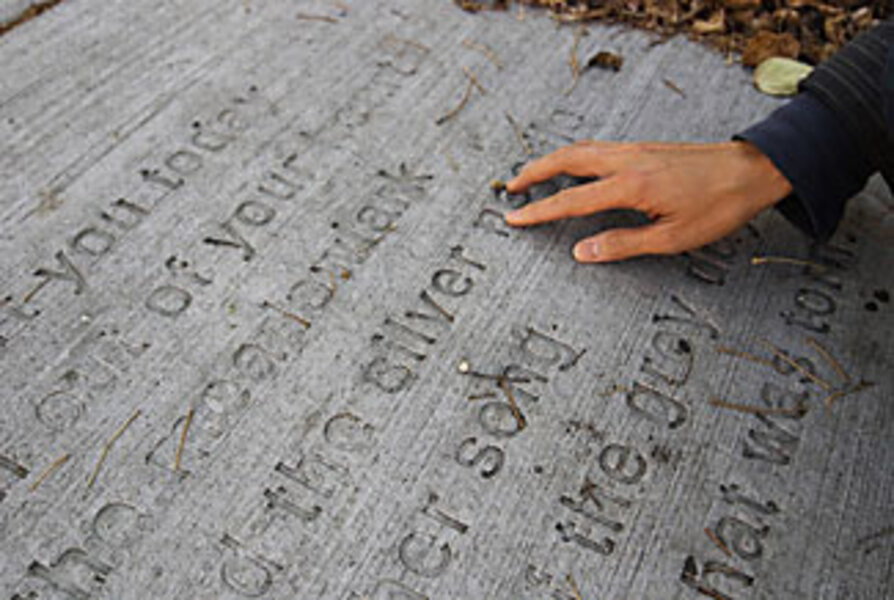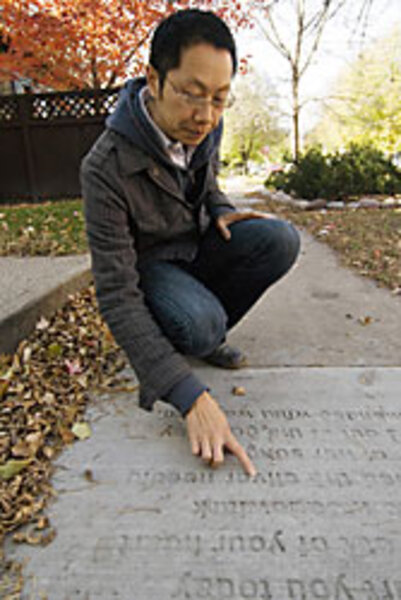Sidewalk stanzas
Loading...
| St. Paul, Minn.
On a damp day this fall, I drove with Marcus Young to Frogtown, a working-class neighborhood on the outskirts of downtown St. Paul. Mr. Young, who was born in Hong Kong and raised in Des Moines, Iowa, has spent the past year stamping oversized poems into cement across the city – a public arts project he calls, with something less than poetic flourish, "Everyday Poems for City Sidewalk."
The poems are scattered as far as Lake Como to the north and the Mississippi River to the west. But a single Frogtown street plays host to four, and we arrived around dusk, when the shadows were fattening.
"It's a universal thing," Young said, peering down at a pile of russet autumn leaves. "You see wet concrete, and you want to do something to it. You want to write your initials. All we've done is sanction that desire." He pushed aside the leaves, revealing "Second Love," a six-line poem by St. Paul resident Carlee Tressel.
Young read it aloud in a lilting, appreciative cadence:
He kissed the girl
in the ballerina skirt.
It was a long one –
like the kiss –
drenching her sneakers
in tulle.
I pointed out that someone had colored in the first few letters of the poem in crayon, and Young smiled. "It will be there for a good number of decades," he said. "If you're a kid growing up around here, maybe you ride your bike by and notice it and say, 'Let's meet near the poem.' Or, 'Let's use the poem for second base.' It gets folded into your life." He continued, "Or maybe there's a word, like tulle, which you don't know when you're in third grade. And then in eighth grade, you learn about the word, and you understand the poem in a different way."
For two years, Young has served as the public artist in residence for St. Paul, a Midwestern city with a serious creative bent. Literature and art flourish here, supported by a network of independent bookstores, coffee shops, and galleries.
One of Young's first goals, when he moved into his office in a dilapidated government building, was to bring that vibrancy to street level.
"The sidewalk in front of your house is public realm, it's city property, but you feel some sort of part ownership," he said. "I knew I wanted to ask people to make a conceptual leap and to think about their streets as a canvas, or, in this case, as a book. And then I thought, 'Well, if it's a book, who's going to get to write in it?' "
So in February, Young convened a panel of judges and announced that the city would host a poetry contest, open to all residents, young and old, published and amateur. The only stipulation was that entries be kept short and that the material be previously unpublished.
With that, the floodgates opened. The poems came from middle schools and universities, cubicle dwellers and bibliophiles, a radio producer, a former resident of a refugee camp in Thailand, a science-fiction writer, and one particularly poetic retired Chinese opera singer.
From those thousands of entries, the judges narrowed the field to 20 poems. This summer, Young took the winning entries to Themescapes, a Minnesota company that helps produce concrete sculptures for water parks and playgrounds. Twenty stamps were made – with each poem rendered in a different font – and turned over to St. Paul's public works department.
Standing in front of a map at his office, Young pointed to a scattershot sprawl of blue pins, each representing a freshly printed and installed sidewalk panel. "Tomorrow, we'll do our 100th installation," he said proudly.
"I see the poems around town," said Sean Fleming, a teacher in the St. Paul public school system. "And every time, because I'm so drawn to words, I stop and I look. We're living these rushed lives, and it's good to stop and ponder a poem."
Earlier this year, Mr. Fleming – along with his students, who were working on a poetry unit in class – submitted a packet of verse for consideration in the contest.
The kids' work didn't make the cut, but the judges liked "Let's Talk," a terse, funny poem by Fleming. (All the winning selections can be read at www.publicartstpaul.org/everydaysidewalk.)
"A public display of literacy and art like this, who knows where it might lead?" Fleming said.
One of the most striking poems was written by Margaret Hasse, a recipient of a National Endowment of the Arts fellowship and the author of three collections of verse. Ms. Hasse said she submitted a few poems, but was happy to learn that "Meadowlark Mending Song" had been selected. "As Emily Dickinson wrote, 'Hope is the thing with feathers.' Humanness was really at the heart of the contest. There were a lot of poems, from a lot of different backgrounds, and really only one defining quality."
"Meadowlark Mending Song" sits on the same street as "Second Love," in front of a handsome old Frogtown home. By the time Young and I arrived at the panel, living room lights were flickering to life inside the house.
"I know it's here somewhere," Young said, kicking through a heap of spilled soil. We both knelt down on the pavement, and I spotted the first line, its letters furrowed with dried mud:
What hurt you today
was taken out of your heart
by the meadowlark
who slipped the sliver needle of her
song
in and out of the grey day
and mended what was torn.






